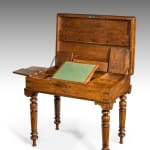19th Century Colonial Padouk and Brass-bound Campaign Desk
31 ¼ x 36 ¼ x 24 in
Further images
-
(View a larger image of thumbnail 1
)

-
(View a larger image of thumbnail 2
)

-
(View a larger image of thumbnail 3
)

-
(View a larger image of thumbnail 4
)

-
(View a larger image of thumbnail 5
)

-
(View a larger image of thumbnail 6
)

-
(View a larger image of thumbnail 7
)

-
(View a larger image of thumbnail 8
)

-
(View a larger image of thumbnail 9
)

-
(View a larger image of thumbnail 10
)

-
(View a larger image of thumbnail 11
)

-
(View a larger image of thumbnail 12
)

-
(View a larger image of thumbnail 13
)

-
(View a larger image of thumbnail 14
)

-
(View a larger image of thumbnail 15
)

-
(View a larger image of thumbnail 16
)

-
(View a larger image of thumbnail 17
)

-
(View a larger image of thumbnail 18
)

-
(View a larger image of thumbnail 19
)

The hinged top enclosing a fitted interior incorporating a series of slotted compartments on the under side of the top, and a series of hinged lidded compartments surrounding a ratcheted baize-covered writing surface, below which a sliding panel reveals an arrangement of secret drawers, with carved volute-form corner bracket “feet”, as alternatives to the turned tapering legs which are detachable.
The life of an officer of the East India Company was largely itinerant so the concept of portable furniture became popular. A number of London-based companies, Morgan and Saunders for example, advertised items that could be dismantle for transport and a number of workshops in India produced their own versions, usually based on an English design. The design of this particular table is unusual as it incorporates the very rare feature of decorative corner bracket feet being available if the turned legs are removed. The legs of this desk unscrew, allowing it to be used on top of another surface or making transportation more practical, whether on board a ship or on travel over land.



















